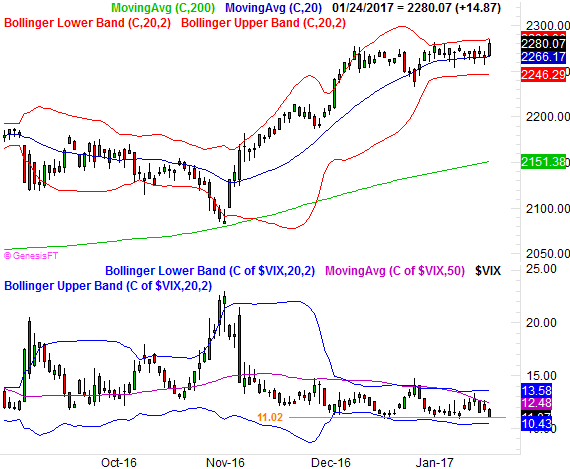The Stock Market’s ‘Fear Index’ May Have Nowhere to Go but Up

The VIX has a negative correlation to stock market returns
The CBOE Market Volatility Index, a measure of fear in the market, is trading at an extremely subdued level that is more symptomatic of a carefree market. But the mood on Wall Street is anything but, suggesting that the volatility index’s foray below 20 may be a sign of turmoil ahead.
The so-called fear index hovered at 11.4 on Tuesday, down more than 2% from 11.8 on Monday. The VIX measures market expectations for volatility over the next 30 days; it’s calculated from the implied volatilities of S&P 500 index options. A low reading indicates traders anticipate a placid market while a higher number suggests elevated uncertainty.
“11.8 is more than one standard deviation away from the VIX’s long term average of 20. Additionally, the VIX rarely goes below 10. Statistically, 11.8 is an unusually low reading for the VIX,” said Nick Colas, chief market strategist at Convergex, in a note to clients.
It may also be worth noting that the VIX is below the average low of 12.2 for January.
“That doesn’t guarantee that we’re at the lows on the VIX for the year, but given January’s propensity to represent an annual low it does merit your attention,” said Colas.
The absence of market volatility is typically welcomed by investors who abhor uncertainty. But since the VIX tends to have a negative correlation to stock market returns, the fear index’s somnolence may be a sign that the market will be getting a jolt soon.
“The VIX often visits its extreme point, high or low, for the year in January. And since we know 11.8 is not likely to the high point for the year, it could well be a low,” he said.
That valuations for large-cap stocks are bloated at 17 times the S&P 500’s average earnings of $130 for 2017 also makes the market ripe for a correction. But the biggest agitator for stocks is the same man who was responsible for the epic market rally of the past two months—President Donald Trump.
“Our traders think equities have run out a little ahead of themselves with the postelection rally. They are still positive for the year as a whole, but feel investors want to see more details about the new administration’s plans before they commit a lot of fresh capital,” Colas told MarketWatch.
While Trump’s policies are viewed as mostly business-friendly, investors are becoming increasingly nervous over the lack of specific details over how he will deliver tax cuts and eliminate regulatory barriers as promised.
Meanwhile, in the event of increased volatility, Colas recommends stocks offering high yields such as utilities, real-estate investment trusts, and consumer staples. Gold GCG7, -0.56% an asset that often serves as a refuge during uncertain times, is also a good bet.
The S&P 500 and the Nasdaq Composite closed at record highs on Tuesday while the Dow Jones Industrial Average resumed its march toward the psychologically-important 20,000 on the back of better-than-expected earnings even as investors girded themselves against more Trump-related uncertainty.
Courtesy of MarketWatch
